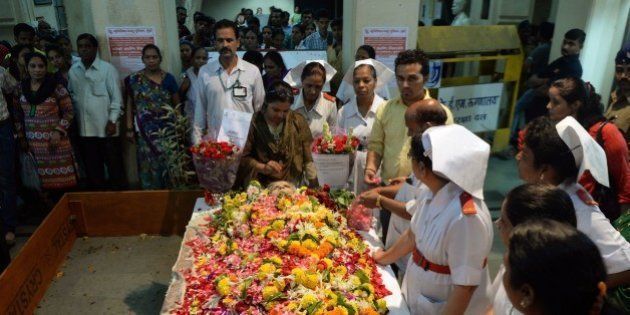
Forming an opinion about someone comes easy. In fact, it's second nature. Forming an opinion on their life or death doesn't appear to be too difficult either. Even if we've never met them.
On Monday morning as news came in from Mumbai's King Edward Memorial hospital that Aruna Shanbaug was no more, India was caught up in the euthanasia debate, hastily opining on an issue nearly as complex as life itself.
Forty-two years ago, on the night of November 7, 1973, Aruna, a nurse at KEM Hospital, was brutally assaulted and sodomised by Sohanlal Bharta Valmiki, a hospital sweeper, who wrapped a dog chain around her neck and yanked her back with it. She was found the next day, unconscious, lying in a pool of blood. The strangulation stopped the blood supply to her brain, rendering her in a vegetative state since. She was just 26 then.
Decades later, it took a petition by journalist-activist Pinki Virani to decide if Aruna should live or be euthanised. The petitioner had argued that Aruna "can neither see, nor hear anything, nor can she express herself or communicate, in any manner whatsoever. Mashed food is put in her mouth, she is not able to chew or taste any food". The author of the book, Aruna's Story, felt the nurse was "virtually a dead person" and should be allowed to "die peacefully".
"They say she relished certain foods like fish, got upset if her room got crowded and was peaceful when devotional songs were played to her."
The supreme court then sought the opinion of a team of three distinguished doctors. After examining her physically and medically the doctors agreed Aruna Shanbaug had no language comprehension or expression, but she was "not brain dead". Nor was she in a coma. They stated, "Her eyes were wide open and from her behaviour it appeared that she could see and hear us, as when one loudly called her name she stopped making vocal sounds and hand movements for a while." The doctors said, "When an attempt was made to feed her by mouth, she accepted a spoonful of water, some sugar and mashed banana. She also licked the sugar and banana paste sticking on her upper lips and swallowed it. Thus, at times she could cooperate when fed."
Interestingly, it was the staff of KEM who fought against Aruna's mercy killing. These were nurses, doctors and paramedics who looked after Aruna day and night as one of their own, not allowing a single bedsore to be formed despite her lying in bed for years and years. Filing a subsequent affidavit against the mercy plea, Dr Oak, the then dean of KEM, noted that taking care of Aruna was the "finest example of love, professionalism, dedication and commitment to one of our professional colleagues who is ailing and cannot support herself. Not once, in this long sojourn of 33 years, anybody has thought of putting an end to her so called vegetative existence".
"Many saw her death as an end to unbearable misery. But for others, including her caregivers, there was always a tiny bit of life in her. "
He concluded his argument with these words: "Aruna lives in her own world...To me any mature society is best judged by its capacity and commitment to take care of its 'invalid' ones."
On March 7, 2011 the supreme court dismissed Pinki Virani's writ petition for Aruna's mercy killing, but allowed "passive euthanasia" under "exceptional circumstances".
Four years later, Aruna has died a natural death and the case for active euthanasia is back on the front burner.
Euthanasia is complex enough an issue, but active euthanasia even more so. For one, should a patient be forced to suffer or should she/he have the right to decide when to call it a day? But then, can we as people ensure the law is not misused? What happens when the person is incapable of giving her or his consent? Who decides on pulling the plug? Will economic considerations become a factor? And what if there is even a one percent chance that the patient's condition will improve?
It is for these reasons that active euthanasia is illegal in most nations. It is legal though in the Netherlands and Belgium, which have some of the best social and healthcare systems in place. In Switzerland euthanasia by a legal practitioner is illegal, but assisted suicide, in which the patient administers the lethal injection himself, is not. Interestingly, euthanasia was legalised in Australia's Northern Territory, by the Rights of the Terminally Ill Act 1995. But the legislation was subsequently overturned by the parliament.
Euthanasia has been a subject of debate for decades, yet there are no definitive answers because it involves not just medical and logical, but ethical, legal, psychological, socioeconomic and existential complexities. Certainly it cannot be argued for or against in 140 characters of a tweet.
As Aruna Shanbaug's body, bedecked with flowers, was cremated in the afternoon, scores of people gathered to pay their last respects. Many saw her death as an end to unbearable misery. But for others, including her caregivers, there was always a tiny bit of life in her. They say she relished certain foods like fish, got upset if her room got crowded and was peaceful when devotional songs were played to her.
The emptiness of ward no. 4 at KEM will be felt not just in its corridors, but in the hearts of every nurse who have worked there. For them she was their child and they couldn't imagine cutting short her life, whatever kind of existence she might have.
Since that fateful night in 1973, Aruna had neither laughed nor cried. But what would have Aruna wanted if she could express herself even slightly? Would she have sought death rather than live in a vegetative state for 42 years? Or was she actually fighting for life all this while? We will never know.
This post first appeared on Governance Now.



Contact HuffPost India